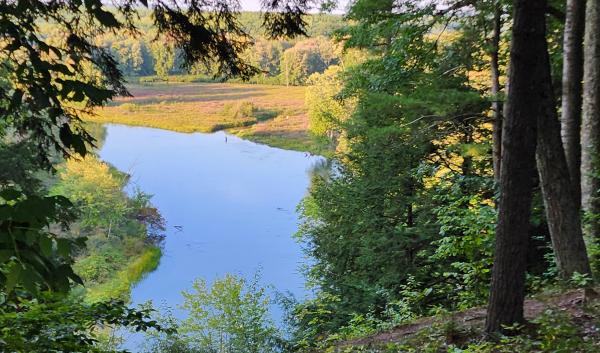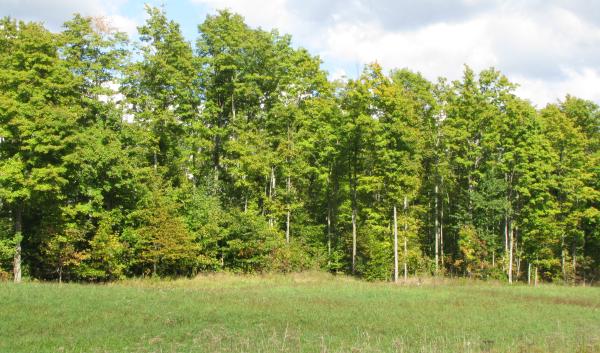Forests across the United States are expected to undergo numerous changes in response to the changing climate. The Forest Adaptation Menu of Strategies and Approaches provides a collection of resources designed to help forest managers incorporate climate change considerations into management and devise adaptation tactics.
Effects from Climate Change
Climate change will affect forests as they experience:
- Shorter, warmer winters
- Increased extreme precipitation and flooding
- Changes in drought and moisture stress
- Enhanced fire risk
- Intensified biological stressors
- Increases in carbon dioxide, a greenhouse gas
Not all forests are vulnerable to a change climate. Longer growing seasons and warmer temperatures will increase suitable habitat and biomass for many temperate species. Upland systems dominated by oak species generally have low vulnerability due to greater tolerance of hot and dry conditions, and some oak, hickory, and pine species are expected to become more competitive under hotter and physiologically drier conditions.

However, changes in precipitation patterns, disturbance regimes, soil moisture, pest and disease outbreaks, and nonnative invasive species are expected to contribute forest vulnerability across the region. Northern, boreal, and montane forests have the greatest assessed vulnerability as many of their dominant tree species are projected to decline under warmer conditions. Coastal forests have high vulnerability, as sea level rise along the Atlantic coast increases damage from inundation, greater coastal erosion, flooding, and saltwater intrusion.
Adaptation in Action
The forests in the Midwest and Northeast region are a defining feature of the region's landscape, are expected to undergo numerous changes in response to the changing climate. This menu contains adaptation actions and provides land managers with a range of options to help forest ecosystems adapt to climate change impacts. Importantly, the adaptation strategies and approaches presented are nested within the existing paradigm of sustainable forest management. A changing climate and the associated uncertainty will create many challenges, forcing managers to be flexible and adjust management objectives and techniques; however, the overarching goal of sustaining forests over the long term will remain a cornerstone of management. Many actions to adapt forests to climate change are consistent with sustainable management and efforts to restore ecosystem function and integrity. Additionally, many current management activities make positive contributions toward increasing forest health and resilience in the face of climate change.

Strategies and approaches
The 10 strategies, 36 approaches, and 100+ tactics were developed through an assessment of existing adaptation tools, focus group discussions, and workshops with natural resource professionals.
Adaptation strategies are very general and can be applied in many ways across different ecosystems and cultural contexts. Adaptation approaches are more specific, describing in greater detail how strategies could be put into practice.
These strategies and approaches are designed to serve as stepping stones to allow natural resource managers and planners to translate broad concepts into targeted and specific actions (tactics) for putting climate change adaptation into practice to achieve a specific management objective in a specific location.
Example tactics are provided in the menu as illustrations of a few of the possible actions that could implemented for climate adaptation.
Menu of Adaptation Strategies and Approaches Developed for Forests
-
Approach 1.1. Reduce impacts to soils and nutrient cycling.
Approach 1.2. Maintain or restore hydrology.
Approach 1.3. Maintain or restore riparian areas.
Approach 1.4. Reduce competition for moisture, nutrients, and light.
Approach 1.5. Restore or maintain fire in fire-adapted ecosystems.
-
Approach 2.1. Maintain or improve the ability of forests to resist pests and pathogens.
Approach 2.2. Prevent the introduction and establishment of invasive plant species and remove existing invasive species.
Approach 2.3. Manage herbivory to promote regeneration of desired species.
-
Approach 3.1. Alter forest structure or composition to reduce risk or severity of wildfire.
Approach 3.2. Establish fuelbreaks to slow the spread of catastrophic fire.
Approach 3.3. Alter forest structure to reduce severity or extent of wind and ice damage.
Approach 3.4. Promptly revegetate sites after disturbance.
-
Approach 4.1. Prioritize and maintain unique sites.
Approach 4.2. Prioritize and maintain sensitive or at-risk species or communities.
Approach 4.3. Establish artificial reserves for at-risk and displaced species.
-
Approach 5.1. Promote diverse age classes.
Approach 5.2. Maintain and restore diversity of native species.
Approach 5.3. Retain biological legacies.
Approach 5.4. Establish reserves to maintain ecosystem diversity.
-
Approach 6.1. Manage habitats over a range of sites and conditions.
Approach 6.2. Expand the boundaries of reserves to increase diversity.
-
Approach 7.1. Reduce landscape fragmentation.
Approach 7.2. Maintain and create habitat corridors through reforestation or restoration.
-
Approach 8.1. Use seeds, germplasm, and other genetic material from across a greater geographic range.
Approach 8.2. Favor existing genotypes that are better adapted to future conditions.
-
Approach 9.1. Favor or restore native species that are expected to be adapted to future conditions.
Approach 9.2. Establish or encourage new mixes of native species.
Approach 9.3. Guide changes in species composition at early stages of stand development.
Approach 9.4. Protect future-adapted seedlings and saplings.
Approach 9.5. Disfavor species that are distinctly maladapted.
Approach 9.6. Manage for species and genotypes with wide moisture and temperature tolerances.
Approach 9.7. Introduce species that are expected to be adapted to future conditions.
Approach 9.8. Move at-risk species to locations that are expected to provide habitat.
-
Approach 10.1 Promptly revegetate sites after disturbance.
Approach 10.2. Allow for areas of natural regeneration to test for future-adapted species.
Approach 10.3. Realign significantly disrupted ecosystems to meet expected future conditions.
Citation
Swanston, Christopher W.; Janowiak, Maria K.; Brandt, Leslie A.; Butler, Patricia R.; Handler, Stephen D.; Shannon, P. Danielle; Derby Lewis, Abigail; Hall, Kimberly; Fahey, Robert T.; Scott, Lydia; Kerber, Angela; Miesbauer, Jason W.; Darling, Lindsay; Parker, Linda; St. Pierre, Matt. 2016. Forest Adaptation Resources: climate change tools and approaches for land managers, 2nd ed. Gen. Tech. Rep. NRS-GTR-87-2. Newtown Square, PA: U.S. Department of Agriculture, Forest Service, Northern Research Station. 161 p. https://doi.org/10.2737/NRS-GTR-87-2
Acknowledgements
The Northern Institute for Applied Climate Science and regional partners led the development of the forest adaptation strategies and approaches, which can be used with the Adaptation Workbook process (published in Forest Adaptation Resources: Climate Change Tools and Approaches for Land Managers). The Northern Institute of Applied Climate Science (NIACS) a collaborative, multi-institutional partnership led and supported by the USDA Forest Service.



